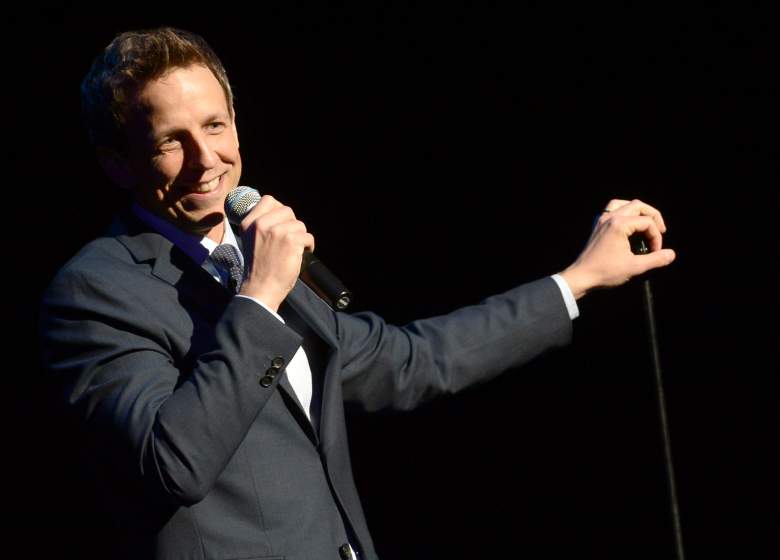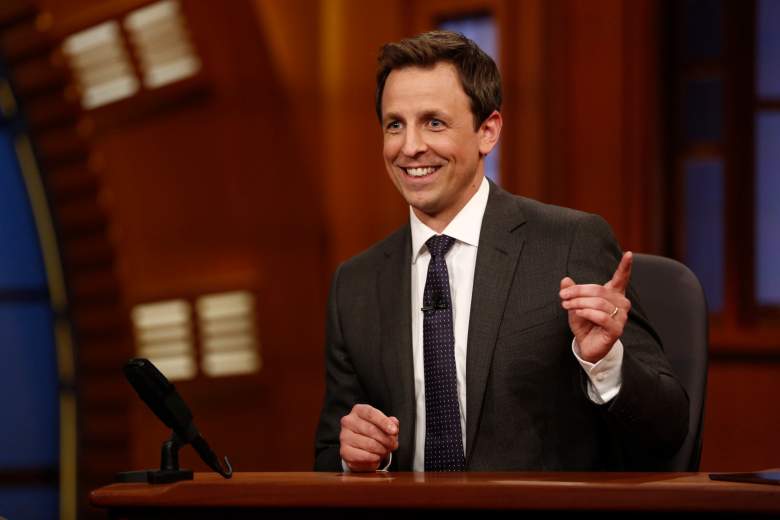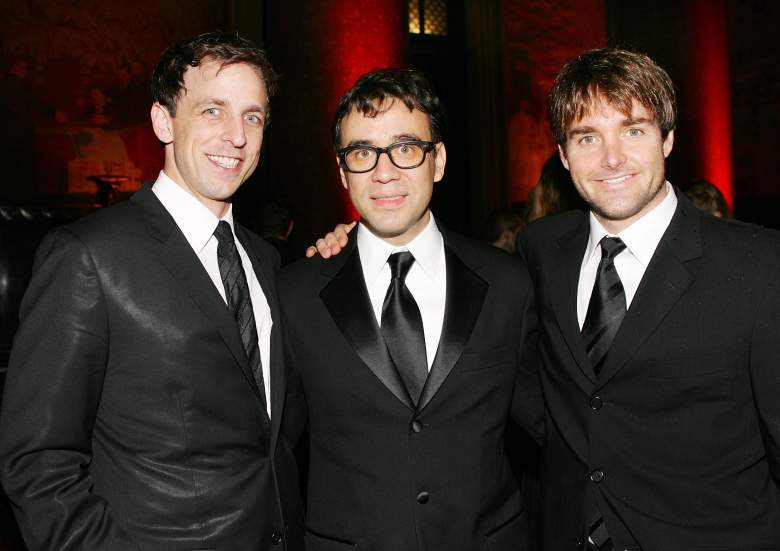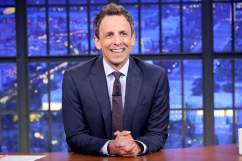
Seth Meyers made a few significant changes that helped his show find it’s footing. (Getty)
When Jon Stewart left The Daily Show in August of 2015 there was no question who would literally take over for him. It’d be Trevor Noah of course. But there was a question as to who would take over for Stewart in a broader sense. Who would be looked upon to fill his role in popular culture? Who would be the voice of outrage among the left and the twenty-somethings who relied on Stewart to interpret the news in a way that made sense to them? Who would be the voice of reason in late night, who would hold the media accountable and who would be the one to find ways to make light of a political climate in America that was growing darker by the day? With all due respect to Noah, it didn’t seem like it was going to him. Not at first at least.
John Oliver seemed like a possible candidate, but with his show only being once a week it could help fill the void, but not do so entirely. Part of the appeal of the Stewart-led Daily Show was it’s presence on a daily basis, being there to offer front line commentary on the news of the day. Oliver is always going to be a step behind in that regard. Two years ago Stephen Colbert would have been an easy answer. Yet after he moved to CBS over a year ago he ditched the character that helped him become a champion of the left. A version of that character has started to pop up on his show now and again and it does seem as if the Trump presidency has lit a fire under Colbert, which is good to see. The Trump Presidency has actually been beneficial for Colbert, with his ratings now higher than his rivals.
This isn’t about ratings, though. This is about finding someone to fill the enormous shoes of Jon Stewart.
Seth Meyers, a veteran of Saturday Night Live, moved to late night when Jimmy Fallon was promoted to host of The Tonight Show in 2014. Late Night with Seth Meyers debuted in February of 2014 and not much was expected of Meyers. The first year of the show was good, but not great. It seemed as if Meyers was struggling to find his voice, find his footing and his place in the increasing crowded landscape of late night television. But a week after Stewart signed off from The Daily Show for the last time, Meyers would go on to make the first of two significant changes that would not only breathe new life into his show, but would show make it clear that Meyers, not Oliver, Colbert or Noah, was the true successor of Stewart when it came to comedic political commentary and serving as America’s comedic translator of U.S. politics.
1. Meyers Ditched the Traditional Monologue Style in 2015, Opting to Deliver His Monologue From Behind His Desk Instead

Meyers’ side steps tradition, delivering monologues from behind his desk (Getty)
It was Monday, August 10, 2015. The audience of Late Night with Seth Meyers finished applauding the introduction of the show’s band, led by Fred Armisen, and then the show’s host surprised everyone. He took a seat. In a move meant to play to his strengths, Meyers elected to forgo the traditional stand-up monologue that late night hosts have been giving since the dawn of time and instead set up shop behind his desk, delivering his monologue, or deskolgue as it became known as.
In an interview with The New York Times the day after the change, Meyers was straight forward when asked about the move. “I’ve always, obviously, been comfortable behind a desk,” Mr. Meyers said. “It seemed like it was time to give it a shot.” Meyers had made a name for himself as the host of ‘Weekend Update’ on Saturday Night Live, and as soon as he made the change, it was obvious it was a move that made sense. From the jump, Meyers appeared more comfortable, more at ease and the show suddenly started to make sense as something different from it’s contemporaries.
Moving the location of his opening monologue could have been interpreted as nothing more than a gimmick to draw attention to a show that badly needed it, but for Meyers, the move was more practical than anything else. “It’s a tried-and-true, tested delivery system,” Meyers said at the time. The move also allowed the show to incorporate visuals to accompany the content of the deskologue, a format employed successfully by Stewart, Colbert and Oliver, among others.
2. Two Years Into His Show’s Run, Meyers Introduced ‘A Closer Look,’ a Reoccurring Segment That Has Become a Viral Hit
The next change Meyers made that inserted him in the conversation of who would be Stewart’s rightful heir was creating a signature segment that would boost Meyers’ profile virally. Almost two years after Late Night with Seth Meyers debuted, the show introduced a new segment, “A Closer Look.” The segment would be an abbreviated version of what Oliver was doing on Last Week Tonight; deep-diving into the topics of the day, combining facts and humor while doing so. It would also afford the show the opportunity to dip it’s toe into political humor, a move that Meyers was eager to make.
As with any kind of new change, it took a little while for the segment to get it’s footing. Yet once it did, Meyers suddenly found himself on the same level as Fallon, as well as James Corden, the host of The Late Late Show with James Corden and Jimmy Kimmel, the host of Jimmy Kimmel Live. Late Night was now able to compete in the ever-increasing world of YouTube. Viral popularity had become an increasingly important metric when judging the success of a late night show and as the 2016 Presidential election entered it’s final months, Meyers saw his YouTube numbers jump by more than 50 percent when it came to subscribers and his monthly views top 36 million.
“A Closer Look” has since gone on to become a reliable, illuminating and entertaining way to digest current events, of which there have been many since Trump took office. Some of the segment’s home runs were tackling Vice President Mike Pence being booed when seeing Hamilton, President Donald Trump’s penchant for lying, and the adventures of California Congressman Devin Nunes.
3. Meyers Relies on a Team of Writers to Help Create Each ‘A Closer Look’ Segment, but it’s Meyers Who Makes it a Finished Product
Yet for these changes to work and for Late Night to succeed, Meyers needed the right people around him. In the early days of “A Closer Look” segment,” the writers of Late Night struggled with the balancing of extensive research and responding with jokes. To successfully nail “A Closer Look” the show would need to bring in a ringer.
Enter Sal Gentile, a former producer at MSNBC and performer at the Upright Citizens Brigade, the legendary comedy launching pad. Gentile’s background in TV news had honed his ability to breakdown stories and process breaking news, two things that would prove invaluable as a member of the Late Night team.
The process of creating “A Closer Look” segment begins with Gentile texting with Meyers about possible subjects. Gentile then sets out to write a first draft. Once that draft is completed, it becomes Meyers’ sole focus for the majority of the day. With input from Alex Baze, a producer on the show, and Jenny Hagel, a writer, Meyers starts transitioning Gentile’s draft into a finished product, fine-tuning jokes, selecting the right graphics to accompany certain bits and making sure the pacing works.
4. Meyers Started Dabbling in Political Comedy During His Time on ‘Saturday Night Live’
Dating back to his run on Saturday Night Live, Meyers has always excelled as an editor of comedy. No where on Late Night is that more evident than the “A Closer Look” segment. Between Gentile, Baze and Hagel, the material and jokes are there. Meyers, according to Vulture, is the closer, coming in at the end of the game throwing heat and securing the win.
Meyers never intended to ever be labeled a political comedian though. At Saturday Night Live Meyers was especially skilled at running with notoriously low-brow ideas, such as “Jon Hamm’s John Ham” or “Peter Sarsgaard’s SARS Guards.” Yet just as with Late Night, there were two significant moves that were made that altered the trajectory of Meyers’ time with the show. The first move was when Meyers was tapped to play John Kerry during the 2004 Presidential election. The second was a promotion. Meyers was named Saturday Night Live’s head writer in 2005.

Seth Meyers with former SNL cast mates Fred Armisen and Will Forte in 2006 (Getty)
Regardless of what line of work it is, one thing is a constant – if you’re the boss, your job is do the things others don’t want to do. On Saturday Night Live, it was political humor and as head writer, writing politically-driven sketches became Meyers’ responsibility. This was especially true during non-election years. If there’s an election happening, there’s a line out the door of people ready to write sketches based on what’s going on. On the flip side though, no election, no takers. So as a result, Meyers found himself falling into the realm of political comedy.
A few years later in 2008, Meyers had grown increasingly comfortable tackling politics and penned the majority of sketches in which Tina Fey appeared as Republican Vice Presidential nominee Sarah Palin.
Meyers either hosted or co-hosted “Weekend Update” from 2006 to 2014 and it’s there where you can see the early seeds of the current iteration of Late Night, specifically the “A Closer Look” segment. Meyers first debuted an early version of “A Closer Look” on “Weekend Update” in 2011. The bit was an examination of Greece’s debt crisis.
5. Meyers Hosted the White House Correspondent’s Dinner in 2011 and Some of His Best Material was Aimed at Donald Trump
Earlier in 2011, Meyers was invited to host the White House Correspondent’s Dinner. While some of the jokes Meyers made at the expense of President Obama were noteworthy, it was his repeated shots at one of the dinner’s guests that drew the most amount of attention and depending on who you ask, inspired a presidential run. Meyers talked about the dinner and the guest in question on his show in October 2016.
Meyers’ set seemed to be enjoyed by roughly 99.9% of the audience, with the one notable exception being our current President, Donald J. Trump, who sat stone-faced during the entire set. Between Meyers’ roasting him, as well as President Obama’s pointed barbs, it was a rough night for the future president and a night that some, including The New York Times, later pointed to as an impetus for Trump’s presidential run. Of course that theory was countered with the reality that Trump had been discussing running for president since the 1980’s. Trump himself threw water on the theory, saying that despite thinking that Meyers’ routine was “too nasty, out order, there are many reasons I’m running,” he told The Washington Post. “But that’s not one of them.”
Nasty? Come on. This joke isn’t nasty.
“Donald Trump has been saying that he will run for president as a Republican, which is surprising since I just assumed he was running as a joke.”
Neither is this joke, which plays off of Trump’s relationship with actor Gary Busey, who had appeared on a season of Trump’s Celebrity Apprentice:
“Gary Busey said recently that Donald Trump would make an excellent president. Of course, he said the same thing about an old, rusty bird cage he found.”
Yet regardless of what Trump has said, Meyers still feels like he played a part in the political rise of our 45th president. As a guest on The Tonight Show with Jimmy Fallon in February, Meyers said “I made fun of him in 2011. That’s the night he decided to run. I kicked the hornet’s nest.”
Whether or not Meyers did actually kick “the hornet’s nest,” I’d say that with the reoccurring genius of “A Closer Look” segments we’re even. I’d also say that it’s official, Meyers has assumed the role abandoned by Jon Stewart.
I for one, didn’t see it coming. I don’t think anyone really did. All that shows is that we weren’t paying close enough attention because Meyers has been laying the groundwork for it for the past decade. From a few jokes on Saturday Night Live to some fine-tuning on “Weekend Update” and feeding lines to Tina Fey, to roasting Donald Trump, and finally to taking a stand by sitting down, Meyers has proven himself to be an intelligent, crafty and flexible comedic genius.
And this has been a closer look.
